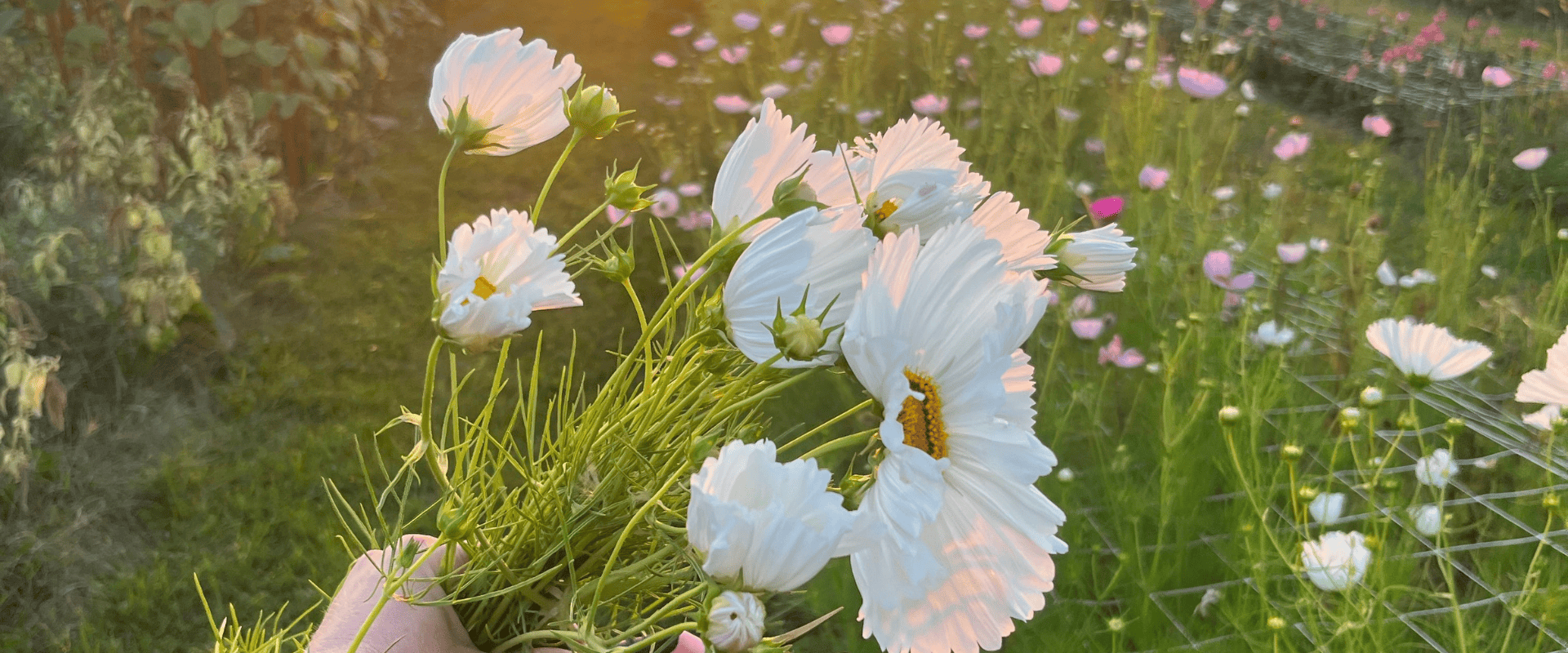
Welcome back to another Sunny Mary Meadow podcast/blog post. I am your host, Liz Fiedler, and today as I’m writing/recording this, it’s Thursday, September 21st, and I am just getting started with fall cleanup. As a reminder, I am in Zone 4B, and our last frost could literally happen at any time. So, we are constantly checking the forecast. There is nothing frost-wise in the 10-day forecast that I can see, there’s not even anything below 43.
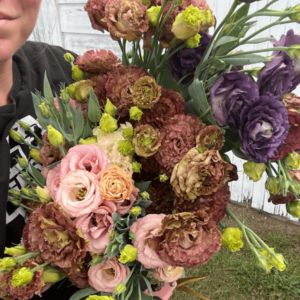
As a reminder, this is season four of growing cut flowers for me and I had never paid attention to frost dates in my life until I started doing this. I will say that three years ago (my first year of growing) the first frost was about September 20th, so it would have been right around now, and everything died. At that point, I didn’t do anything to try to save anything … it was just done.
Then the next year was the first year of growing after Josh had passed away. He passed away in December of that first year, and I found out I was pregnant. I had Davie that August, so I was on maternity leave through mid-November from my nurse practitioner job and I remember thinking that year, “What the heck, why won’t your flowers die because I am so sick of cutting you and selling you?” I just wanted to be done with the season and it was like October 20, which is a really long time to be continuing to cut these flowers. But, yet, they were profitable, so I didn’t want to just tear them down. So, I basically had to wait until after October 20th to start the garden cleanup. It was fine because I was still recovering from giving birth six weeks prior. I probably shouldn’t have been doing tons of garden work yet, but here we are.
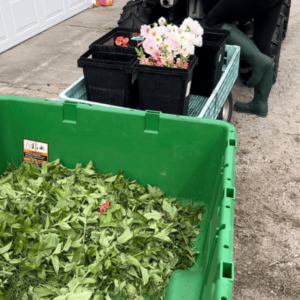
Then I think last year the first frost was somewhere around October 10th or something like that. We’ll see what happens this year. I, for sure, don’t think it’s going to be before October 1st, but I’m just keeping a close eye on it. I really do want to continue to try to sell the dahlias to get more bang for my buck and have them as focal flowers in arrangements.
We’re going to do a few episodes about fall cleanup. There’s so much that goes along with fall cleanup and fall preparations. And everyone always asks, “What do you do in the offseason?” Well, honestly, I’m basically flower farming from the very beginning of April when I start harvesting my tulips until, for sure, late November. It’s full-on flower farming in April, May, June, July, August, September, October, and November for sure. Eight months out of the year, I am actually farming, because I have high tunnels that extend my growing season. We start picking things from the high tunnels in April and then the high tunnels get planted in November when it’s too cold to do stuff outside if it is too cold.
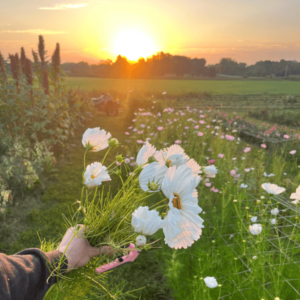
For example, I will plant my tulips in late fall. I have 26,000 tulips coming for next year. I’m planning on planting about 10,000 of them inside the high tunnels and the other 16,000 or so will be outside depending on what the space allows. I’m definitely going to get the stuff grown outside done first because the stuff inside of the high tunnel can definitely be done at a later time if it’s cold, if it’s rainy, if it’s snowy, whatever the weather conditions are. So, planting inside the high tunnels takes a lower priority or it can be done as fill-in. Lindsay is here three days a week, so I have to take advantage of when she’s here. If she’s coming and it’s going to be 37 degrees and rainy in late October, we’re not going to be outside planting tulips in that weather … I’m not that mean. But we can go inside the high tunnel and plant tulips on those days. So, I’m trying to capitalize on that unpredictable weather and just make a plan. Peddling perishable products takes planning.
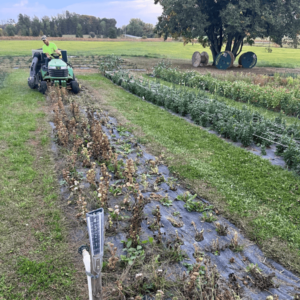
I think the topic of what I do in the fall is probably going to be three or four parts honestly – fall cleanup, fall preparation, fall tasks, etc. Today, I want to talk about the importance of taking notes on your flower farm. Honestly, I’ll say this year that I need to do better at it. I have a notebook that I have, and I need to just write everything down. I do take notes on my phone on my notes tab. And I want a Google Doc for Lindsay and I to both be able to use. But honestly, just having a good old-fashioned notebook to write things down by hand sometimes is the best. The act of seeing it physically there helps because we get so desensitized by our phones. When I look at my phone, I don’t think I don’t think of adding to my farm notes. But when I see my notebook sitting there, I do think about adding to my farm notes. So, sometimes that visual reminder is so important since we get desensitized to the things that we see every single day.
Or you can set aside time, maybe every Sunday night at 7:00 p.m., for example, to sit down and do it. Or, in the summertime, walk through the flower farm and just reflect on everything. So, what worked? What didn’t? What did we have fun doing? What sucked? What did we all grow? And what are we? What are we done doing? What do we not want to do anymore? What do we actually want to grow and what do our customers want us to grow? And then keep track of those things.
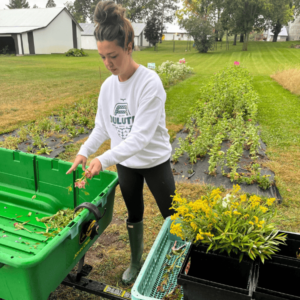
I did that for a wedding that we did. We did our first full-on wedding as a florist last weekend and we went through, and we wrote down things like, “What did we like about it? What did we not like about it?” We asked ourselves questions like that. Our bride had a pretty dream flexible vision and didn’t have a super strict budget on what it had to be, so we were not limited to what we could get. We could really just kind of dream big and get the flowers that we wanted, which was so fun. They turned out beautiful because we didn’t have any limiting factors like that, but I did ask Lindsay (my right-hand gal), “Would we have had fun if these flowers were not exactly how we could have dreamed? If we were limited on resources of what we could buy? Would they have been as fun? And she’s like, “Oh, yeah, it would have been as fun because we would have made them pretty.” I’m like, “Yeah, until it’s Fourth of July, and some bride wants leatherleaf and red roses, blue thistles, and white something … you know like red, white, and blue. I don’t know. That’s not gonna be as fun for us.” So, it’s important to take notes on how you feel because it’s so easy at the moment to forget about that and forget about those emotions.
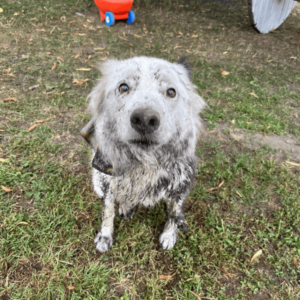
For the farm, we think about things like, “What do we actually enjoy doing? Is there something we dread picking every single time or something we dread netting?” Or if there’s a task that we hate doing, then do we actually have to grow those flowers? Do we really need to? They take so much time compared to everything else. I mean, I’ve even thought about reducing the number of zinnias that I grow because they take so much longer to harvest because you can’t tell if they’re ready or not by looking at them. You need to wiggle them and see if they’re ready, so they can just take longer. So, it’s so important to take notes of what you’re doing and how you’re feeling throughout the entire season.
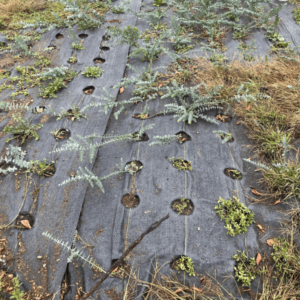
So now, I am actually going to go through and give you notes of everything that Lindsay and I wrote down, which it’s probably only about 30 things. We should have been adding to it sooner. However, remember that I am in year four of growing, so there are a lot of things that we don’t need to write down because I have already perfected them. I’ve already eliminated the things that are an absolute waste of time to grow. I’ve already eliminated the really obvious things, so my notes are probably a little bit more fine-tuned. Lindsay wrote a lot of these as we drove together down to a Twins game a couple of months ago, which is about 80 miles away. And then again when we drove to Clara City to get some flowers from another flower farmer, also a couple of months ago … or maybe one month ago, I don’t even know. The summer went by fast. So a lot of these were things that I said out loud and she wrote it down or vice versa.
- I think the very first thing that Lindsay wrote down was “Need triple zinnias – May 8, 2023.” That was when we did our first succession and she wrote, “Two rows immediately and one row later.” So not actually triple the zinnias, just triple zinnias … meaning a third row of zinnias. Right now, we have two rows (and our rows are 5 ft by 60 ft), so she wrote “two rows immediately and a third two weeks later.” That would allow us to have that continuous succession to have fresh blooms.
- Feverfew – We have not been growing feverfew here, but I got some from some other local growers and we’re definitely going to expand on that.
- Statice – Right now, we are growing purple status. We are going to add apricot, white, and light pink next year.
- Celosia – We need to grow more of this.
- Benary’s Giant Zinnias – We want some giant zinnias. We didn’t do a ton of because they have to be picked at a certain time and their vase life isn’t the greatest if you don’t pick them at the perfect point, but we do want some of them.
- Snapdragons – More varieties – orange and pink. I did a lot of the rocket ones and I think I want to do the Potomac variety next year because they are just a lot hardier.
- “Ask area farmers/ask around about early bloomer dahlias” – What do people have that blooms early in Minnesota?
- “One more row on each end of dahlias.”
- “Far end first impressions (zinnias)” – So the very far ends of our flower row were just kind of ugly when our “You-Picks” started because they were the bupleurum and the stock that had finished blooming out. And we more or less decided we didn’t even think about it. But when people walk down to the meadow to pick their own flowers, those are the very first two rows that they see and those are the rows that they usually walk through … and they’re really ugly. So, we definitely don’t want to put those down at the far end to improve the first impression.
- We wrote, “Grow some eucalyptus” – meaning grow less. We had quite a bit this year and in Minnesota, it takes so long for it to get long enough to use, that we’re going to do less of that.
- “Different colors of gomphrena” – this year, we did a raspberry color that I think is called Audray Purple. And we decided to add orange and white next year.
- “Staking zinnias with T-posts” – Honestly, this is a tossup. We’ve thought about corralling them, but they do pretty well without it. They’re not knocking over at all. The Oklahoma varieties and the Queen Lime varieties that we grow, especially, do well on their own. So, I don’t know, I’m going to put a question mark next to that one. At one point, we decided we needed to do it, but right now, on September 21st, I don’t know anymore. I think they’re just fine. Around early August, we thought we should have done that, but things changed.
- We wrote “less snapdragons or divide into four colors.” This is also kind of a tossup; we had thought that but now I don’t know. We had a lot of snaps in July, but we only had two colors of them. We definitely want like four colors, just to keep us from getting bored. That being said, next year, we’re going to have even more subscriptions and when trying to make as many bouquets as we do, we will want more quantity of less ingredients. If we’re making 50 bouquets a day, multiple days per week, it just makes it so much easier. For example, if we have 100 white snapdragons, 50 lime green zinnias, 100 orange statice, 100 of something else, and 50 of something else, it makes it go so much quicker. Because we can say, “Okay, two of these, one of these, two of these, and one of these – we can make one and if it looks good then we can make 50 of them that are the same. If we are making every single bouquet a little bit different because we’ve maybe got 30 of these, 20 of these, and 40 of these, then we have to spread it out and be so much more mindful about the ingredients that we use. Because of that, we want larger quantities of fewer things, because it makes subscriptions go so much faster when we’re making them.
- We do want to grow some blue thistle perennials. This might be literally the one thing that we plant from seed or get some seed trays of it. I need to look into that. A lot of people love it. Brides love it. It’s a perennial around here, we’re going to look into that.
- Lindsay wrote “Sedum x 10,000” – we do want to transplant a bunch of Autumn Joy sedum in our perennial beds, which is farther away from the rest of the flowers. It’s fine if it starts looking ugly, or weedy, or whatever. We just pick from it as we need it. I think we’re going to add way more sedum because from the beginning of June through frost time, we can use it as needed. We also want to add more yarrow to the perennial’s beds.
- We are going to grow more scabiosa.
- We want different kinds of amaranth than we grew this year. We could eliminate probably a third of our amaranth plants. We pinched it way too late, so then we kind of just hacked it down. It just did nobody any favors.
- We are going to do more successions of bupleurum.
- Stock – we just wrote this with a question mark. If I’m being honest, I don’t think I’m going to grow any stock next year. I absolutely love it. It’s fragrant. Maybe I’ll get one tray of it next year, just to have for fun, but honestly, it takes just as much work to plant anything else, and it’s a one-and-done plant. Which means once you cut it, it’s done. Whereas each snapdragon plant gives us probably 30 or 40 stems throughout the entire summer. That might be an exaggeration, it’s close to that. It’s probably two stems a week from literally late June through frost, if you average it out. And we get that big flush again in the fall, whereas a stock is done after blooming once, and then you have to plant something else in its place. And while they’re pretty, nobody is coming to our flower farm for the stock. Nobody is like, “Oh, where’d your stock go?” It smells pretty, and it’d be nice to have like one in a bouquet, but the snapdragons look very similar, and they keep producing. So I just think with the amount of work they take, what we get, and what we sell them for, I don’t think we’ll do it.
- We wrote, “Put some basil down in the main garden and grow more of it.”
- Lindsay wrote, “The side of the hill zinnias.” What that means is on the other side of our high tunnel, we just want to put all zinnias there. We don’t need to worry about any crabgrass going through, we really don’t need to weed it, and it’s just nice so that we can leave the zinnias in the “You-Pick” area and then pick the ones by the side of the hill for subscriptions if we need to.
- Next, we wrote, “Try to plant Bells of Ireland, bupleurum, orlaya, and feverfew this fall” – If you go back to my episode on cool-hardy annuals, you will hear us talk about annuals that do really well in cold weather as we have in Minnesota. Every year we have some that have gone to seed on their own in my beds and they pop up on their own in the spring. We always have a couple of those plants and it’s because they self-seeded (went to seed and dropped their seeds). Well, my thought is, “What if we wait until like late October, when we know the soil is cool enough and it’s not going to germinate, and we just plant the seeds this fall? And then hope that first thing in the spring they’ll come up.” I want to see how it goes. I want to prep the beds, plant a couple packets of seeds, mark them with flags, so we know exactly where they are, and see how it goes. Then, at the very least, the beds are already prepped, we can use our Dibbler so we don’t have to work the soil too much, and then we can just see how it goes and try to get plants earlier in June.
- We want to grow more dara.
- Lindsay wrote, “frosted explosion on the hill” – I think what that means is we know that we have frosted explosion there already, so we don’t need to plant any.
- “Baby’s breath, depending on how it starts growing” – I did buy about 40 plugs of baby’s breath this year. They are just starting to bloom now, but they were planted pretty late. But they are perennials, so I don’t know. I think that we are going to just try to transplant them and see what happens next year. I think the second year, the bushier plants will produce more baby’s breath. I do have the white variety and the pink one.
- “Plant liatris” – yes, we want to plant more liatris. They’re just nice perennials to have in bouquets around July.
- “Spirea is nice for June” – Yes, it is. I want a couple more spirea bushes, even around the house. We can use them.
- “Less pink, more earthy tones” – Yes, we have way too many pink flowers. We love, love, love pink around here, except for the fact that not everyone loves pink in September. So, I think we just need some more neutral pinks that we can carry into fall. We probably want less pink snapdragons, less pink statice, less pink gomphrena. Whereas, if it’s like a pink strawflower, or a pink dahlia, that’s a lot more fall looking, because it’s a lot more textured … I don’t know how else to describe it. It almost blends more into the earthy tones a little bit.
- “Net the lisianthus much earlier and have two or three tiers of netting” – We only had one tier on them this year, and we didn’t put it high enough, which meant our netting basically did nothing. We also need it tighter so that it can actually do its job.
- Lastly, we wrote, “big fillers” – I don’t know what that means. I’ll have to ask Lindsay what that means. I’m thinking, maybe, amaranth that has bigger leaves or is fuller. Either that or more fillers? I don’t know.
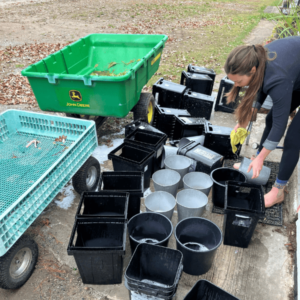
This kind of concludes what will likely be just the first part of our series on fall preparation – it’s essentially taking notes, keeping track of, and reviewing everything that we did throughout the summer. We have to order our seeds soon and we have to order our plugs (like snapdragons) on October 2nd already. That is why it’s so important to start planning now and making those changes for the spring. Then, we will get our seeds ordered and have a plan there, so that we can kind of flip the beds in a timelier manner.
One last thing … podcast listeners and blog readers, I have an ask of you. Between planning these episodes, recording, editing, uploading, and transcribing the podcast to a blog, and the fees to even have an account, this podcast/blog takes a lot of time, effort, and resources. I’m fortunate to have a team helping me out but it’s time to evaluate where this podcast is going and if we can continue doing this. I have had so many messages and emails letting me know that this podcast/blog has brought some bit of joy to people’s day or week and is entertaining, inspiring, or on some other day just improves their life, their drive, whatever it might be. I want to keep this podcast/blog focused on content that informs, entertains, and is mindful of your time. One way to accomplish this is through direct listener support. Your support would help the podcast and blog not only continue but grow. Because of these, we are introducing Sunny Mary Meadow Premium. It’s a way you can quickly and easily support the podcast/blog, and the whole thing takes about 60 seconds. We are asking for $7 per month to help continue our mission of educating and entertaining you. If the Sunny Mary Meadow Podcast and/or Blog is a part of your day or week, and you love what you’re hearing/reading, please consider supporting us. As a special thank you, you will receive access to weekly bonus podcast episodes of what we did on the farm that week. They will be anywhere from 5 to 15-minute episodes. So think of that $7 as a high-five to keep us going and creating the episodes. It’s less than $2 a week just to keep us going and allow us to share this information with you. Thank you for your support!

Additional Note from Liz: Hey, everyone! I want to talk quickly about my course that I’m launching this fall, Peddling Perishable Products. Essentially, if you like the episodes where I tell you how to grow the flowers, I really think you’re gonna like the episodes where I tell you how to sell the flowers. Ultimately, I tried creating some podcast episodes talking about how I do things, and it just felt incomplete, and I really want to make a difference. I want to make it easier on you, and I don’t want you to find out how to do things the hard way.
If you want more information on how to sell your flowers and turn them into a comprehensive business, go HERE and sign up for a Calendly call. I promise it’s not intimidating. It’s 15 minutes where I’m going to tell you the stats on my sales, and I’m going to ultimately give you information on the course. If, at the end of the phone call, the answer is no or not yet, I promise no hard feelings. I just really, really want to help you turn your flower hobby into a successful business if that’s what you want to do. Again, no hard feelings, just sign up on the Calendly link. Thanks!
Thanks for reading the Sunny Mary Meadow blog. If you like what you’re reading, please subscribe to the podcast and rate us. You can also find us on Instagram, Pinterest, and Facebook.
You can subscribe to our email newsletter below. We love to hear any podcast-related feedback at our email podcast@sunnymarymeadow.com, and all other inquiries can be sent to liz@sunnymarymeadow.com.